INTRODUCTION
Space occupying lesion at the subungual area is commonly diagnosed as a glomus tumor which accounts for 1%–5% of soft tissue tumors of the hand and 75% of glomus tumors are subungual [
1,
2]. The clinical triad of point tenderness, intermittent severe pain, and cold hypersensitivity accounts for preoperative easy diagnosis. However, ganglion cyst at the distal phalangeal joint which is known as mucous cyst occasionally grows up infrequently into the subungual area and mimics the clinical course of the glomus tumor [
3,
4]. Although cold intolerance is unique in glomus tumor, nail deformities and sharp tenderness are frequently accompanied in both the cases. The authors encountered a subungual ganglion cyst, which was erroneously diagnosed preoperatively for glomus tumor and compared both the lesions systemically with the literature review.
Go to :

CASE REPORT
A 54-year-old woman visited our outpatient clinic with nail deformity and pain at the tip of the right thumb. She underwent mild injury on her nail root of right thumb at a nail shop 3 months back. Subsequently, nail deformity aggravated gradually. Physical examination revealed a convex point with tenderness on the right thumbnail. The nail revealed proximal ridging and elevation of the nail plate accompanying the V-shaped notch without nail destruction (
Fig. 1). Cold hypersensitivity was denied and ice cube test was negative. However, a soft tissue tumor was suspected at the subungual area, which occurs most commonly in glomus tumors and other possible space-occupying lesions. Osteophyte of distal interphalangeal (DIP) joint was found on X-ray examination (
Fig. 2A). On Doppler ultrasonography, a 0.43×0.26×0.53 cm
3 sized non-specific cystic lesion with hypoechogenicity and no abnormal vascularity was observed (
Fig. 3). Under digital nerve block of the thumb, the thumb nail was extracted with bilateral incision at the level of eponychium to expose the cyst which was placed at the subungual area. During surgery, revealed subungual area cyst had thin wall and contained clear mucinous fluid of jelly-like consistency (
Fig. 4). Examination revealed 0.5×0.5 cm
2, whitish, and round shaped cyst after complete excision of the lesion (
Fig. 5), which was unlike the glomus tumor. The incised portion of the nail bed was loosely re-approximated with 7-0 Vicryl and the nail plate was replaced and sutured in place. For removal of osteophyte, additional incision was added along the radial side of thumb to the interphalangeal joint level, and then burring was performed at proximal and distal phalanx at interphalangeal joint level. Since the osteophyte was placed partially under the insertion site of extensor tendon, minimal injury of radial side of the extensor tendon was inevitable. Pathologically, tissue biopsy revealed a ganglion cyst (
Fig. 6). Seventeen days later, total stitch out was done without any complications on her right thumb. Following surgical treatment, there was no recurrence but deformed nail appearance and scar on the radial side of the thumb were noted during the follow-up of 2 years (
Fig. 7). Written informed consents were obtained.
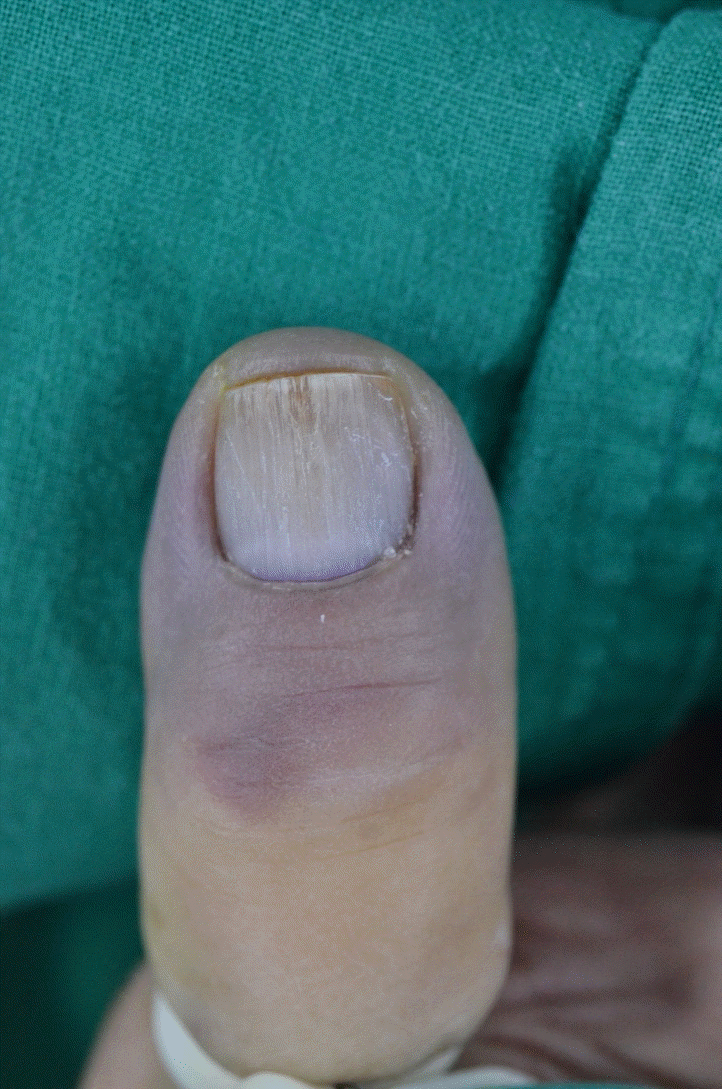 | Fig. 1.Preoperative photograph on right thumbnail with deformity. 
|
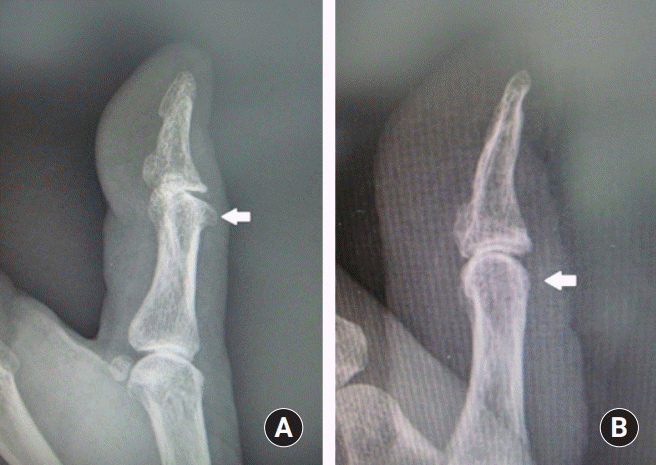 | Fig. 2.Osteophyte of interphalangeal joint of the right thumb. (A) X-ray before removal of osteophyte. (B) X-ray after removal of osteophyte. 
|
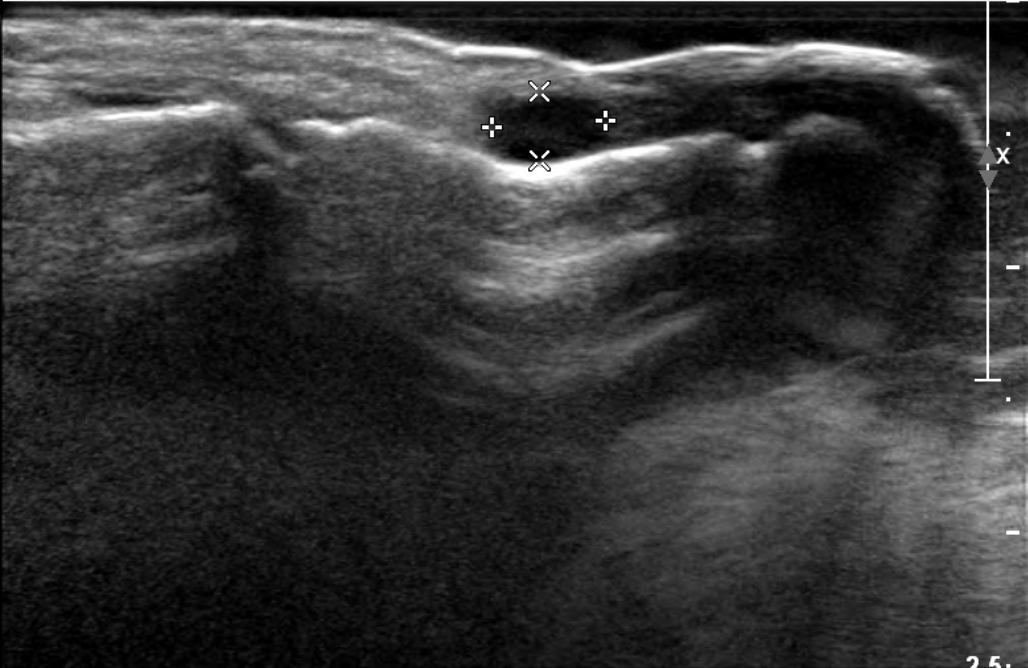 | Fig. 3.Preoperative ultrasonographic findings. 
|
 | Fig. 4.(A, B) Intraoperative photographs of a whitish, irregular, jelly-like round soft tissue mass on the right thumbnail bed. 
|
 | Fig. 5.Postoperative photograph of 5×5 mm2 sized ganglion cyst. 
|
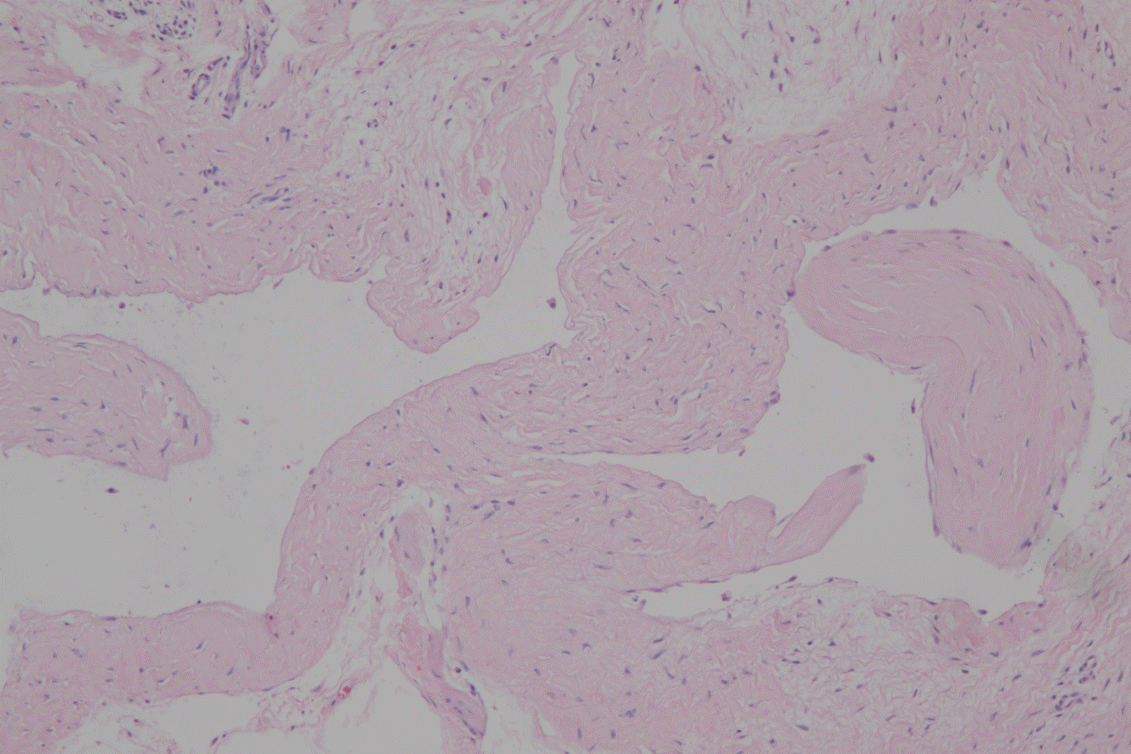 | Fig. 6.Pathologic findings of soft tissue mass isolated from the right thumbnail bed. Microscopic finding reveals multiseptated thin walled cystic lesion containing clear, mucinous fluid. The walls are composed of dense fibrous tissue with no specialized lining cells. These findings are very consistent with ganglion cyst (H&E ×100). 
|
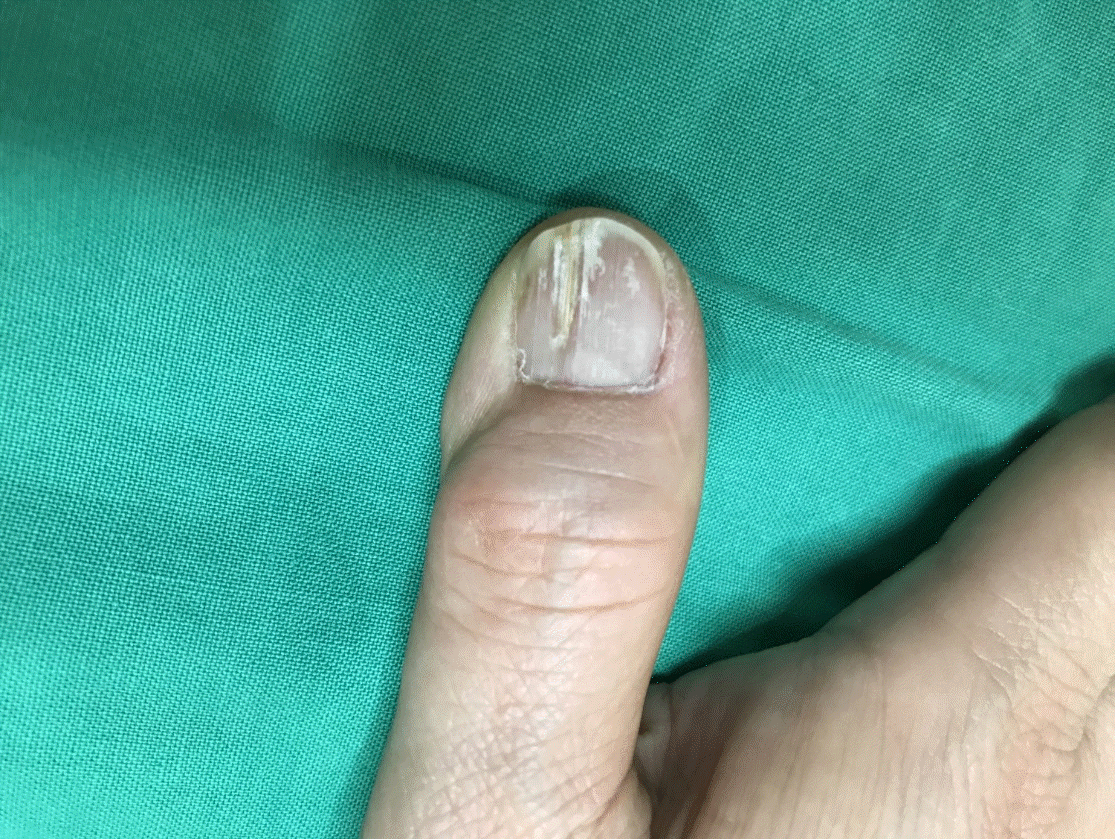 | Fig. 7.Postoperative photograph on right thumbnail with deformity after 2 years. 
|
Go to :

DISCUSSION
A variety of subungual masses have been diagnosed as a myxoid cyst [
3], hemangioma [
5], fibroma [
5], neurofibroma [
5], neuroma [
6], schwannoma [
6], keratoacanthoma [
6], onychomatricoma [
6], squamous cell carcinoma [
6], and malignant melanoma [
6]. Among them, malignant tumors are seldom truly subungual and easily differentiated from benign tumors based on external appearances. Ulceration through the nail, bluish color change, and destruction of the adjacent tissues raised the possibility of the malignancy. However, clinical manifestation of the subungual mass is often non-specific, and accurate diagnosis is always dependent on postoperative histopathologic examination.
Subungual ganglion cysts (SGC) affecting only the nail shape are distinctly unusual and difficult to diagnose, as they are unlikely to display mucoid discharge [
3,
4]. Although de Berker et al. [
3] reported large series of SGCs exhibiting red lunula, altered transverse nail curvature, and variable nail destruction, many of them seemed to accompany the external distortion around the DIP joint. Consequently, subungual mass is usually considered to be the glomus tumor with its predominant occurrence at its specific location under the nail. Furthermore, the authors esteemed the present case as a glomus tumor based on physical examination accompanied by pain and blunt tenderness while cold intolerance was not eminent.
SGC has somewhat different clinical features from that of the mucoid cyst arising from the DIP joint which usually accompanies definitive erythematous swelling and ulceration at the dorsum of the DIP joint [
7]. Contrary to the glomus tumor, in the present case, X-ray revealed osteophyte at the interphalangeal joint preoperatively (
Fig. 2) and focal hypoechoic masses on the ultrasonogram, thereby suggesting subungual mucinous lesions (
Fig. 3).
Ultrasonographic characteristics of cystic, echogenicity and vascularity are helpful for the differentiation of subungual tumors [
5]. Hemangioma shows well-defined and hypoechoic mass and pyogenic granuloma reveals more echogenicity with small hypoechoic foci. In case of subungual epidermal cyst [
7], hypoechoic or anechoic subungual masses with variable echogenic foci are noted. However, differentiating them is always not possible solely based on ultrasonographic characteristics due to non-specific findings [
5]. Magnetic resonance imaging is an excellent imaging modality for detecting small subungual mass as small as 0.2 cm [
8]. SGC reveals a hyperintense mass on T2-weighted imaging with well-defined margins and typically a non-enhancing center with higher specificity.
SGC is variously named as a subungual myxoid cyst, digital mucous cyst, mucinous cyst, myxomatous degeneration cyst, and epidermal cyst [
7]. It represents ganglia of the adjacent DIP joint, which originates due to leakage of the fluid from the joint into the surrounding tissues. Osteophytes and degenerated, rough articular surfaces may lead to inciting damage to the joint capsule. A fluid-filled stalk may or may not be seen connecting ganglion cyst to the adjacent joint [
9]. However, Tomoda et al. [
10] reported the case of ulcerating subungual myxoid cyst, caused by overproduction of mucopolysaccharides and differentiated it from the SGC based on lack of connections with joint sacs.
Considering that the subungual space is a very thin area with 0.1–0.2 cm thickness and rich in glomus bodies and blood vessels with compact innervation, bony erosions are also very common with its pressure effect. Within the limited submatrix space, proximal upward pressure from the subungual mass and the tethering downward force of the lateral proximal attachments of the matrix can cause various nail deformities [
11]. Space occupying lesion under the nail matrix could affect its microvasculature resulting in various nail deformities based on the degree of distortion of the nail matrix [
7]. Color of the lunula, nail curvature, and nail integrity might change and reveal ridge, distal split, and superficial longitudinal split. Brown et al. [
7] traced long-term nail change and growth patterns subsequent to various treatments. They surgically approached with T- or H-incisions to expose the DIP joint. However, in the present case, nail was removed with the standard subungual approach. Surgical excision is the typical existing treatment and removal of the osteophyte from the region of the DIP joint as well as the cyst is imperative [
3].
We propose that hand surgeons should perform differential diagnosis of subungual masses including SGC with reference to symptoms and appropriate diagnostic imaging studies preoperatively, though usual consideration of subungual mass as a glomus tumor. We believe that present findings will aid in precise excising with an aim to reduce the chances of recurrence of SGC. Excision of whole ganglion including the cysts which originate from ligament and segment of joint capsule reduces the recurrence.
Go to :








 PDF
PDF Citation
Citation Print
Print







 XML Download
XML Download